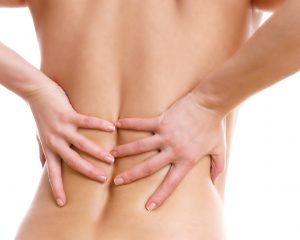 To recognize that the pain you’re experiencing is kidney pain, it’s important to understand where the kidneys are located. Your kidneys are located in the upper abdominal area against the back muscles on the left and right sides. Kidney pain is different from back pain. It is often experienced deeper and higher – beneath the ribs – whereas back pain is commonly felt in the lower back.
To recognize that the pain you’re experiencing is kidney pain, it’s important to understand where the kidneys are located. Your kidneys are located in the upper abdominal area against the back muscles on the left and right sides. Kidney pain is different from back pain. It is often experienced deeper and higher – beneath the ribs – whereas back pain is commonly felt in the lower back.
There are numerous causes for kidney pain such as kidney stones, urinary tract infection, and trauma to the kidneys, to name a few.
Advertisement
Symptoms that may accompany kidney pain include painful urination, fever, flank pain, nausea, and vomiting.
If you’ve been stricken with kidney pain, the tips below will help you achieve relief through natural means. It’s important, though, that you bring your kidney pain to your doctor’s attention because the underlying cause can be quite serious. These natural remedies can be used in combination with your treatment for better pain relief.
Natural remedies for kidney pain relief
- Lots of water: Staying well hydrated can prevent the formation of kidney stones and help flush out bacteria that could contribute to a UTI.
- Fresh lemon juice: Acid found in citrus fruits like lemons helps break up and dissolve kidney stones. For best results, use fresh lemon instead of lemon-flavored beverages. Begin drinking lemon water as soon as you wake up and continue throughout the day. You can also mix olive oil with lemon juice for added benefits.
- Dandelion tea: Dandelion tea works as a diuretic, which means more urine will be released to help flush out toxins. Dandelion tea also stimulates circulation, which keeps the kidneys healthy.
- Watermelon seed tea: Watermelon seed tea also works as a diuretic to help flush out toxins, and it can help stimulate the kidneys to function better.
- Celery seeds tea: Celery helps promote the elimination of waste. Some studies have shown it increases urine output, too. Plus, celery’s antifungal properties can help fight off bacteria.
- Corn silk tea: Corn silk tea works to reduce pain while passing urine and can help promote healing from infection.
- Parsley tea: A proven diuretic, not only can parsley be consumed as a juice or tea, but it can be used topically, applied as a paste to the painful area for pain relief.
- Cabbage leaves poultice: Cabbage is believed to be able to push out toxins from the body. You can directly apply cabbage leaves to painful areas. To make a poultice, you will need cabbage leaves, onions, bran, small amount of water, and gauze. Place cabbage leaves, chopped onions, bran, and water in a pot. Boil it for about 20 minutes. Within this time, the water will evaporate completely. Now place the prepared poultice on the gauze. Apply this hot gauze with poultice to the painful area. Keep it there for at least a couple of hours. If needed, you can leave it overnight.
- Marshmallow root: Marshmallow root is a diuretic that greatly helps in reducing pain while urinating. It coats the lining of the urinary tract, projecting it from damage.
- Plantain: Although commonly thought of as a useless weed, plantain actually has antibacterial properties and is a natural anti-inflammatory. A mild diuretic and laxative, it can easily be made into a tea for easy consumption.
- Uva ursi: Also known as bearberry, uva ursi has long been used to treat UTIs as it is a natural diuretic. Uva ursi should not be used in the long term, so consult a herbalist prior to use.
- Sage-peppermint tea: Both sage and peppermint work to relax muscles and have antiseptic properties. As natural anti-inflammatories, they can relief pain and spasms.
- Mustard plaster: Creating a mustard plaster or poultice can allow you to put the healing properties of mustard directly on the painful area to reduce pain. You will need mustard powder, flour, water or egg whites, and Vaseline or lard. Mix mustard powder with flour. Use water or egg white to make a thin paste. Egg white prevents blistering. The mixture should be thin enough to spread smoothly, but not watery thin – it will flow away. Spread Vaseline or lard over the irritated area. Now apply the prepared mustard plaster. Leave for some time, no more than 30 minutes. You should remove the plaster (wipe off or wash off) if you feel more irritation or if the skin gets deep red or blistered.
- Nettle tea: Sometimes, kidney pain can progress into joint pain. If that is the case, then nettle tea can help alleviate joint pain. Not only is nettle tea a diuretic, but it can help treat inflammation, too.
- Tomatoes: Tomato juice has been known to help eliminate infection, all the while reducing pain. You will want to use a natural or organic tomato juice with no added sugar or other additives. You can easily make tomato juice at home, too.
Prevention tips for kidney pain
 Kidney pain is commonly caused by urinary tract infections, kidney stones, and direct trauma, so kidney pain prevention entails preventing these causes. Here’s what you can do to reduce your risk of developing kidney pain:
Kidney pain is commonly caused by urinary tract infections, kidney stones, and direct trauma, so kidney pain prevention entails preventing these causes. Here’s what you can do to reduce your risk of developing kidney pain:
- Stay hydrated and drink plenty of water to promote urination and expel bacteria.
- Don’t hold in your urine.
- After a bowel movement, wipe front to back in order to discourage bacterial movement from the rectum into the urethra.
- Take showers as opposed to baths.
- Gently wash skin around the vagina and anus – do not use harsh soap or scrub vigorously.
- Empty your bladder as soon as possible after intercourse.
- Avoid the use of scented deodorants and scented feminine hygiene products near the genitals.
- Eat a low-oxalate diet.
- Reduce cholesterol levels.
- Exercise regularly.
- Avoid injury to the kidneys.
- Reduce your intake of red meat.
Sources:
http://www.medicinenet.com/kidney_pain/article.htm
http://www.rapidhomeremedies.com/remedies-for-kidney-pain.html
http://homeremediesforlife.com/kidney-pain/
//www.belmarrahealth.com/bladder-infection-cystitis-causes-symptoms-and-prevention/
